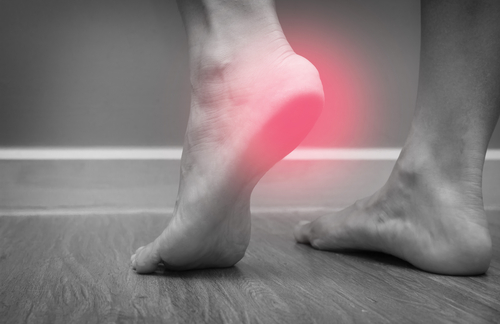What Can You Do To Get Rid Of Your Heel Pain?
This article is the third in a series of six on common running injuries. Our first two articles discussed knee pain (anterior knee pain or patellofemoral pain) and iliotibial band (ITB) syndrome in runners and how to best treat conservatively. Please refer to these articles located on our Blog page…
We will address the most common heel problem, plantar fasciitis. To better understand plantar fasciitis, it helps to understand the anatomy of the plantar fascia.
WHAT IS THE PLANTAR FASCIA?
The plantar fascia is a thick flat band of fascial inelastic tissue located on the bottom of the foot connecting the heel bone to the toes. It provides support to the arch of the foot and undergoes tension when the foot bears weight. It plays an important role when walking becoming “spring-like” when pushing off the toes.

WHAT IS PLANTAR FASCIITIS?
Plantar fasciitis is a common painful degenerative condition that occurs to the plantar fascia on the bottom of the heel slightly toward the instep.
The precise cause of plantar fasciitis is unclear. A heel spur or bony enlargement may develop at the insertion site of the plantar fascia. This may be due to stress on the bone from the plantar fascia but has also been found in asymptomatic people. It is important to note the plantar fascia is causing the pain, not the heel spur.

WHAT IS THE DIFFERENCE BETWEEN FASCIITIS AND FASCIOSIS?
“Itis” at the end of a word indicates “inflammation of”. Conditions that end with “itis” often respond well to anti-inflammatories, ice and rest.
“Osis” indicates degenerative changes to a tendon or fascia. Plantar fasciitis should be re-named plantar fasciosis as it rarely responds to anti-inflammatory treatments due to degenerative changes to its fascial makeup. The treatment focus should be creating changes to the make-up of the tendon or fascia.
WHAT ARE THE COMMON COMPLAINTS WITH PLANTAR FASCIITIS
- Gradual onset
- Pain and tenderness to the bottom of the heel toward the instep where the plantar fascia inserts into the heel bone
- Experiencing pain when taking the first step in the morning getting out of bed
- Issues with pain during periods of prolonged walking
- After prolonged sitting you feel pain when walking
- Feels like there is a “pebble” in shoe
Please note, if there are complaints of numbness or tingling, it is unlikely plantar fasciitis and other conditions must be considered.
WHAT ARE SOME RISK FACTORS FOR PLANTAR FASCIITIS?
- Middle age
- Standing a large portion of the day
- Tight calves
- Obesity
- Flat feet
- Running
WHAT CAN YOU DO TO RELIEVE PAIN RELATED TO PLANTAR FASCIITIS?
- Check your feet: If you have high arches that do not collapse when you walk/run, your feet are likely rigid, so select a shoe with cushion. If you have flat feet or an arch that collapses when you bear weight, you most likely have a flexible foot and need a shoe with stability to control this excessive motion.

- Choose your shoes wisely. Seek help from a knowledgeable sales person able to assess your feet and suggest appropriate shoes. If you live in the New River Valley, I highly recommend RunAbout Sports.
- Stretch:
- Calves: gastrocnemius and soleus
- Plantar Fascia
- Active calf stretching before getting out of bed




- Massage: Cross friction massage may be very effective to relieve pain by promoting collagen healing and increasing circulation to decrease adhesions and scar tissue.
- Night splint: Sleeping with your toes pointed down will make your plantar fascia stiff. The night splint will keep your plantar fascia on a slight stretch reducing the stress to your fascia when getting out of bed and bearing weight. Here is a link to a good night splint you could purchase.
- Tape: There are many ways to tape the plantar fascia. KT (kinesiotape) can often reduce pain. There are also taping techniques to reduce how much the foot flattens when you walk.

- Over the counter or custom orthotic: If your arch collapses when walking, you may benefit from an over the counter orthotic to reduce the amount of collapse and lessen the stress to the heel. Custom orthotics are rarely necessary.

WHAT ARE SOME RUNNING FAULTS THAT MAY CAUSE HEEL PAIN?
A common fault runners who suffer from plantar fasciitis have is a heavy heel strike. As described in the knee pain article (see article), working on decreasing your stride length and increasing your step rate may be indicated.
If you are unable to manage your pain with the above suggestions, consult with a medical professional well versed in treating runners with plantar fasciitis. A videotape analysis may be necessary to determine if running mechanics are part of the cause. Strength, joint mobility and range of motion will be evaluated and appropriate treatment will be implemented.

